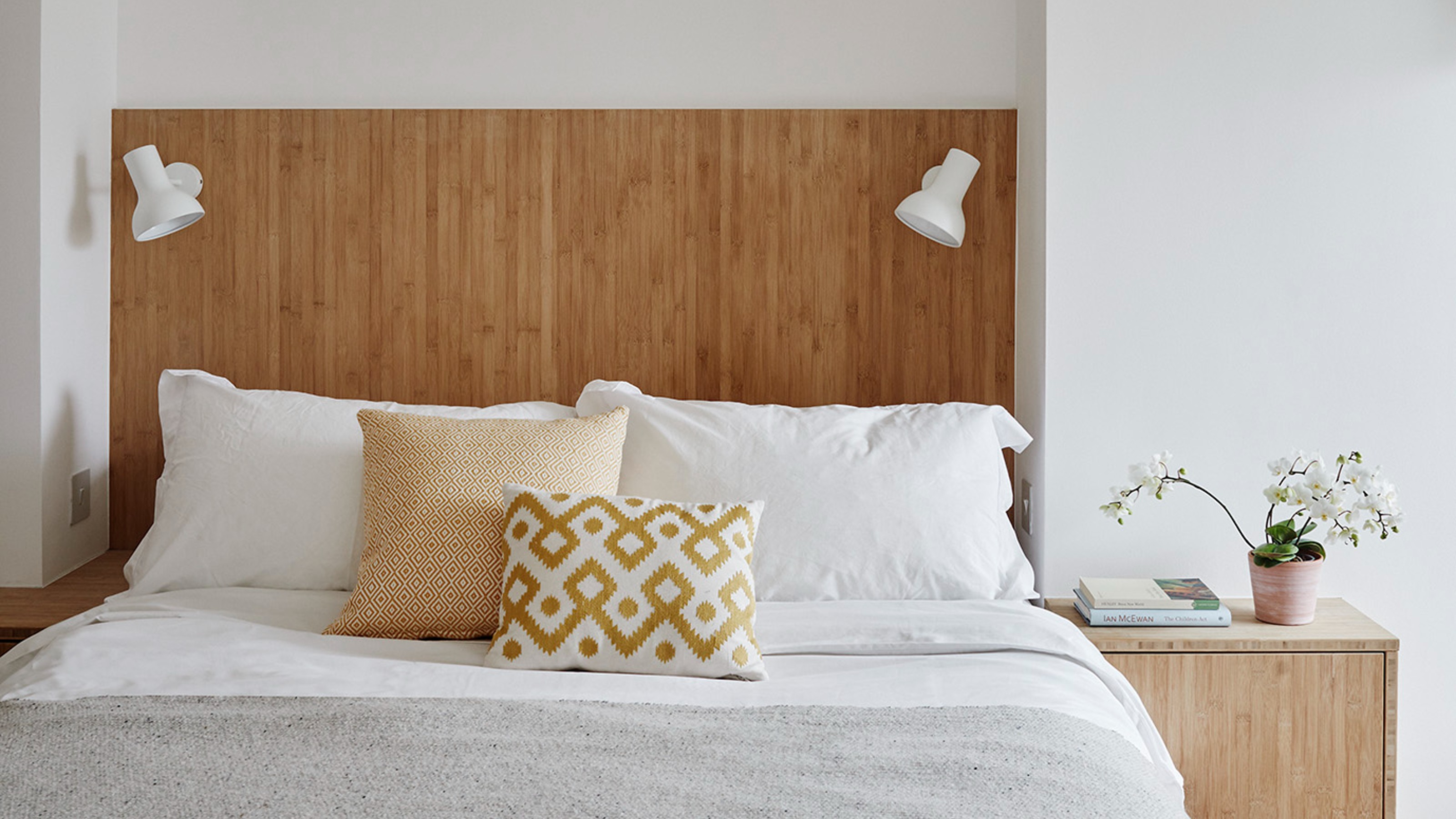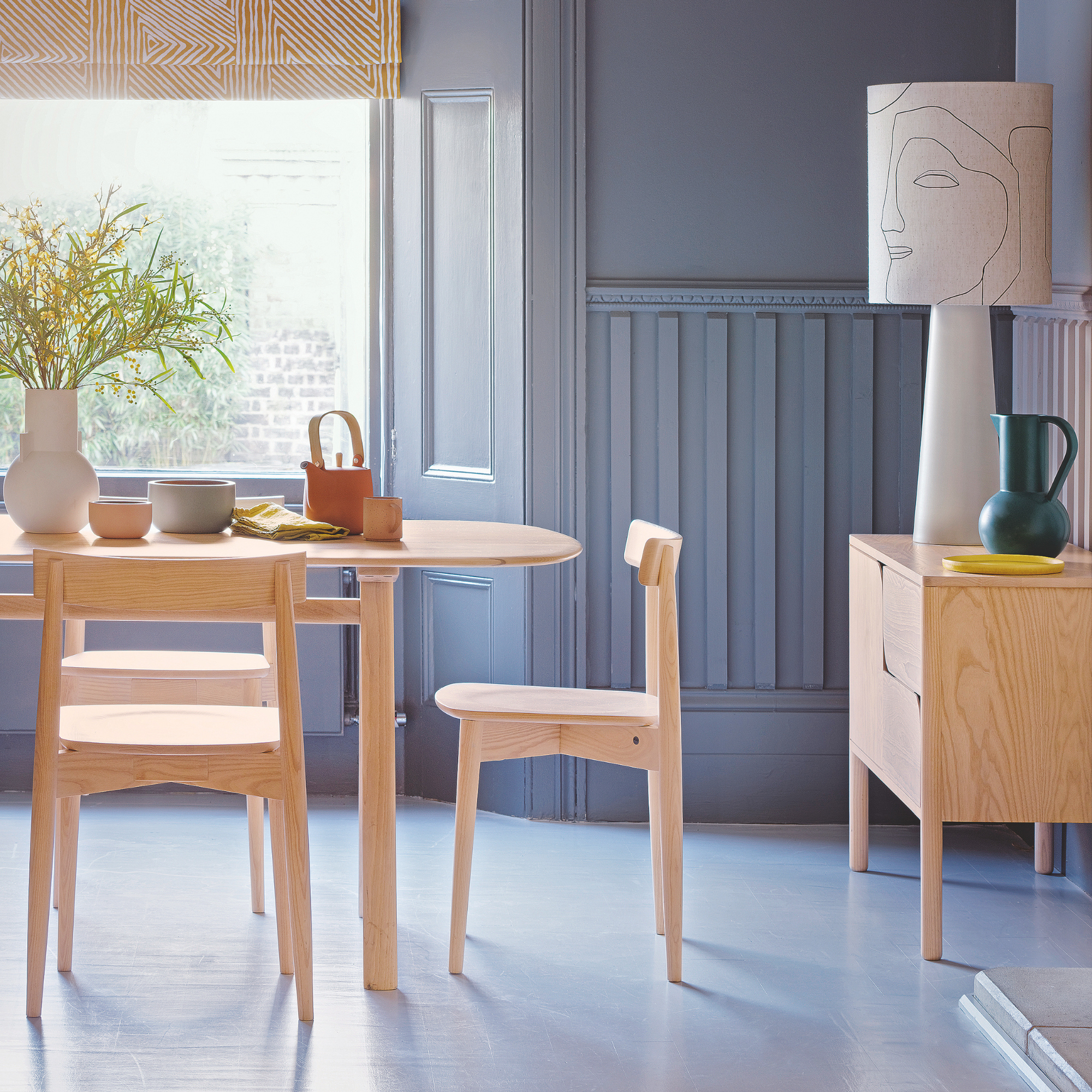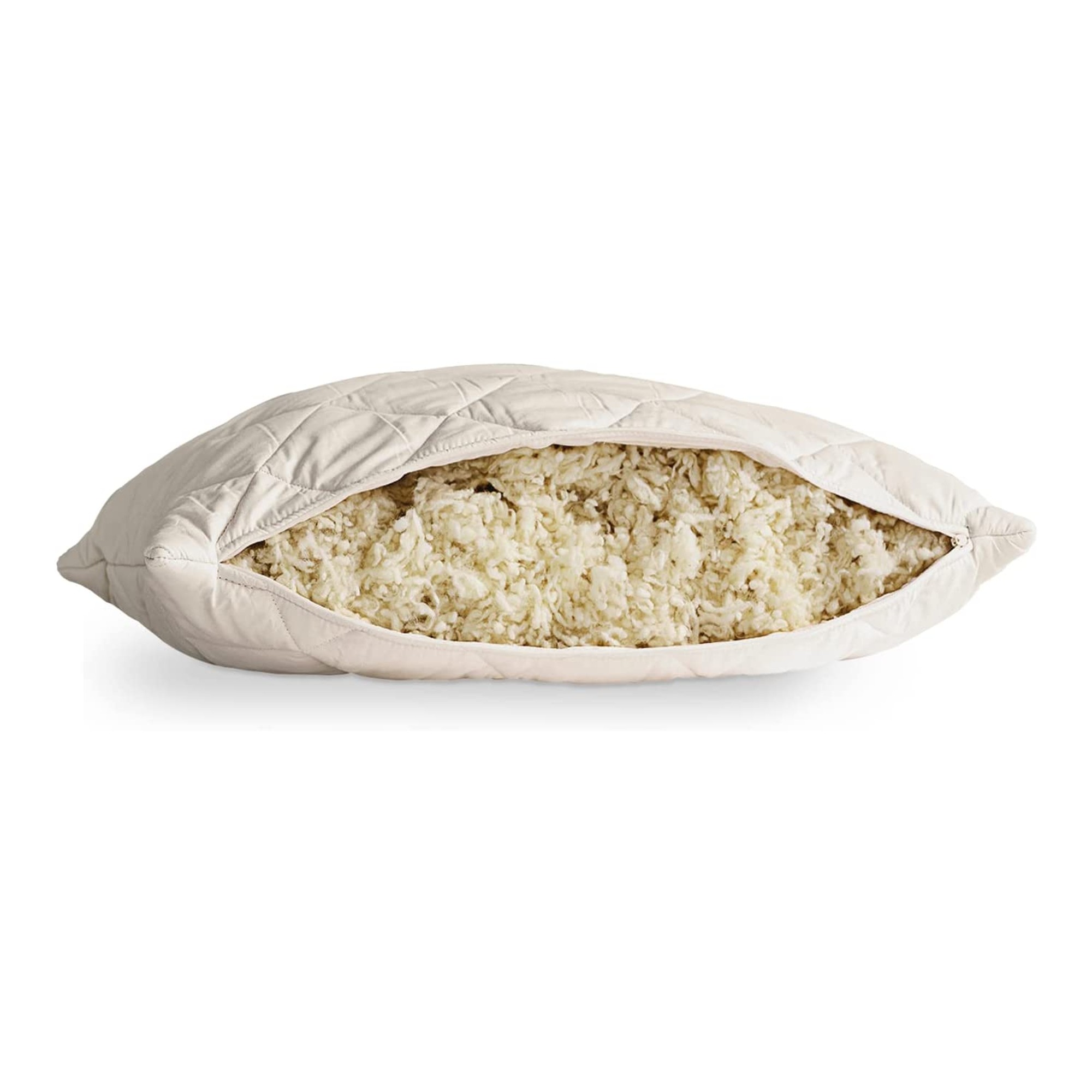The best filling for a pillow revealed – and there's something for every sleeper at all budgets
Time to upgrade the flat old pillow you've been using and enjoy comfy support


There’s a wide range of pillow fillings out there, and each has its pros and cons. When it comes to the best filling for a pillow, it's helpful to know just how many types are out there. Some of the most popular fillings are feather, foam and wool, but that's just the tip of the iceberg.
Finding the best pillow for you involves understanding not just what the fillings are, bit what filling suits you specifically. Just as with choosing your perfect mattress and duvet, everyone's needs and preferences are different, so we've broken down each of the types of pillow fillings that are available and who they are best suited to and why, to ensure you can pick the perfect pillow.
What types of fillings for a pillow are there?

‘Filling types in pillows can be categorised into natural which covers your duck and goose feather and down blends, silk, wool and even latex,’ says Olivia Shykles, filled bedding buyer at John Lewis.
‘You then have synthetics or polyester fillings, although this may sound simple, depending on how it's made can give a variety of different feels and price points. Last but not least you have your foams which are slightly more specialist and can lend themselves to more unique shaped pillows.’
You’ve come here for some expert intel on pillow fillings, so let’s do a deep dive…
Down and feathers
Down and feather pillows include duck down and goose down. Across the board, whether your feather hails from a duck or goose, this type of pillow is thought of as premium.
Feather and down are great insulators, keeping you at the right temperature all night. The feathers trap warm air in, without overheating you.
This type of fill is also considered pretty comfortable for most sleepers. Feathers and down will contour to your head, gently supporting you and keeping your spine aligned as you sleep. They’re also a lightweight and durable pillow filling. ‘The proportion of down adds softness – down is the best quality, a mix of feather and down offers a good value compromise,’ says Olivia from John Lewis.
However, down and feathers do trap moisture, which can build up over time meaning it can exacerbate allergies, so making sure you know how to wash feather pillows properly is key.
They’re also obviously not vegan friendly – there are concerns over animal welfare in the production of feather and down products, so always check the provenance. Also, down and feather pillows can be pretty expensive.

Wool
Wool is another natural fibre found in some pillows. Wool is excellent at regulating your temperature, and wicking away sweat. It’s also naturally hypoallergenic, antimicrobial and naturally fire retardant so wool pillows are less likely to be treated with any concerning chemicals.
However, wool isn’t for everyone. They’re less fluffy than down and synthetic pillows and provide slightly less support. Indeed, the filling needs fluffing every now and then. They’re also not suitable for vegans.
Polyester
Polyester is a man-made fibre, and is brilliantly durable. Similarly to choosing the best mattress for allergies, those with allergies might prefer polyester to natural fill pillows because they’re often hypoallergenic, and can be washed on hot washes. This means more of those dust mites can be blitzed – dust mites are one of the main causes of allergies in the home.
Polyester pillows are also lightweight, and can contour to the shape of your head, giving you lots of support. There’s a huge range of polyester pillows out there, meaning you can find something to suit you. And happily they’re pretty affordable.
However, polyester pillows aren’t for everyone – some people find themselves overheating when they use them. They aren’t known for being very breathable. And the filling can also clump together – especially after washing.

Memory foam
Memory foam mattresses are extremely supportive, and the same goes for them in pillow form. People with bad necks and backs often find them the best type of filling for them. Memory foam is activated by your body heat and pressure, and moulds to the shape of your body.
They’re also great for those with allergies – memory foam is so dense that dust mites struggle to permeate it. ‘Memory foams are great if you are looking for more specialist treatments and finishes, like cooling and temperature regulating,’ adds Olivia from John Lewis.
But memory foam pillows aren’t for everyone. Not everyone likes how dense they are, and they don’t look fluffy on your bed. Older memory foam can be quite bad at overheating too – although modern memory foams have reduced this issue.
Latex
Latex pillows aren’t super common, but there are lots of benefits to this pillow filling. They’re a sustainable choice, as latex comes from a renewable source. And they’re durable too, meaning you won’t need to replace them too regularly. They’re also naturally cooling and hypoallergenic, and breathable too. ‘Latex pillows are great if you’re looking for more specialist support,’ says Olivia from John Lewis.
Some people don’t get on with latex pillows though. They are very firm, which isn’t for everyone. And they can be pricey. It hopefully goes without saying, but they’re not suitable for those with latex allergies.

Hybrid
As with hybrid mattresses, hybrid pillows look to bridge the gap between natural and synthetic fibres. These harness the breathability and softness of natural fibres, such as bamboo or cotton covers, with the support of memory foam.
But, much like memory foam and latex, these pillows are more firm and dense. They can’t be fluffed up, and might look a little less inviting on your bed than down or synthetic-fibre pillows.
Our favourite pillows

We consistently name this the 'Best Overall Pillow' thanks to its adjustable fill which means it can work for front, back and side sleepers alike.
How to choose the best pillow filling for you
‘Choosing the best pillow all lies in what kind of sleeper you are, are you a luxury seeker, sleepy head, sink-in snoozer or a twister and turner, and do you sleep on your back, front, or side?,’ says Sally Bonner, sleep expert at Silentnight.
There are a few factors you need to think about when choosing the right pillow filling for you. The first is your sleeping position. When it comes to the best pillow for side sleepers, typically memory foam really works to maintain spinal alignment, whereas front sleepers might want a low-profile pillow such as wool or down and feathers. Back sleepers need a mid-height pillow that will provide support without putting pressure on their neck.
You also need to consider if you have allergies. If you are prone to allergies, go for something hypoallergenic – synthetic, wool and latex are all brilliant for this.
And of course take in your own ethical considerations. If you’re vegan, you’ll want to go for a product that hasn’t had animals involved in its production. If sustainability is a big factor for you, then look for pillows made from renewable sources and with traceable fibres where applicable.

What is the best pillow filling for hot sleepers?
If you’re a hot sleeper, you’re going to want to opt for something breathable and temperature regulating to help you stay cool in bed. As we’ve already explored, there’s plenty of options out there.
‘People often gravitate to pillows with natural fillings if they feel warm at night as these are classically more breathable helping us to keep cooler as we sleep,’ says Olivia from John Lewis. ‘However there are many clever specialist synthetic pillows with engineered fibres to make them more breathable and treatments designed to target temperature and moisture management as we sleep.’
‘The Silentnight Airmax Pillow is a great option as it features mesh sides for increased airflow to promote breathability and reduce overheating,’ says sleep expert Sally.
What is the best pillow filling for allergy sufferers?
Allergy sufferers will do well to search out hypoallergenic pillows.
‘I would say look to a synthetic pillow or something with a specialist treatment if you are an allergy sufferer as these are often targeting the problem directly and can be washed at higher temperatures,’ says Olivia from John Lewis.
As well as synthetic fibres, wool and bamboo are both naturally hypoallergenic – and latex is brilliant for allergy sufferers too.
What is the best pillow filling for easy-care?
The easiest care pillows are probably synthetic polyester pillows. They are easy to wash and dry, and are durable and pretty forgiving too.
‘The majority of our pillows across natural and synthetic fills are washable, however feather and down needs to be dried with care which can be tricky to do at home. So I would recommend a synthetic fill pillow if you are looking for something really easy to care for,’ says Olivia from John Lewis.
‘Pillows filled with microfibre are perfect for easy-care, as this material is machine washable and fast drying,’ says Silentnight’s Sally. ‘Being able to regularly machine wash your pillows will help them to remain fresh for longer and extend their life.’
With all this info in hand you should be able to choose the perfect pillow to help you meet your sleep goals night after night.
Get the Ideal Home Newsletter
Sign up to our newsletter for style and decor inspiration, house makeovers, project advice and more.

Zoe is a freelance journalist and content strategist. Her career has traversed kids' publishing, women's lifestyle magazines, luxury property and content marketing. She's worked for the BBC, STYLIST, Marie Claire, heat, Wallpaper*, InStyle, The Sunday Times Style, Ocado, Christie's and more. She now regularly writes about interiors and sleep for a range of media – what she doesn't know about mattresses isn't worth knowing.
-
 A top-to-bottom renovation has turned this Edwardian house into a lovely family home
A top-to-bottom renovation has turned this Edwardian house into a lovely family homeWith a few considered structural changes, this period house has been turned into a family home and has created a sanctuary for years to come
By Maxine Brady
-
 How to heat a conservatory
How to heat a conservatory7 practical options to consider for year-round comfort
By Amy Reeves
-
 Blueberry is the ‘it’ blue this spring - but these are the 3 colours you should never pair with it, according to experts
Blueberry is the ‘it’ blue this spring - but these are the 3 colours you should never pair with it, according to expertsAvoid overpowering your space by avoiding these three bold colours
By Kezia Reynolds
-
 Dunelm has given its cult snuggle chair a new look - it's swapped classic stripes for another emerging pattern trend
Dunelm has given its cult snuggle chair a new look - it's swapped classic stripes for another emerging pattern trendI'm obsessed with this fresh new style
By Kezia Reynolds
-
 I tried Joseph Joseph's pan set with foldable handles – the space-saving design is just one of the many highlights
I tried Joseph Joseph's pan set with foldable handles – the space-saving design is just one of the many highlightsSmall kitchen? I tested this innovative Joseph Joseph space-savvy set which has foldable handles — and I loved it
By Annie Collyer
-
 As a stylist, I spend hours looking for bedding for photoshoots, and I just spotted these 6 expensive-looking sets at M&S
As a stylist, I spend hours looking for bedding for photoshoots, and I just spotted these 6 expensive-looking sets at M&SGet a little luxury at a high-street price
By Laurie Davidson
-
 I've been waiting to try out the Ninja Slushi for months – this is what happened the first time I tried it
I've been waiting to try out the Ninja Slushi for months – this is what happened the first time I tried itThe Ninja Slushi is the stuff of dreams for summer entertaining
By Molly Cleary
-
 IKEA has drenched its BILLY bookcase in this year’s ‘it’ colour - but you’ll have to act fast if you want to get your hands on one
IKEA has drenched its BILLY bookcase in this year’s ‘it’ colour - but you’ll have to act fast if you want to get your hands on oneI'm obsessed with this gorgeous limited-edition colourway
By Kezia Reynolds
-
 My go-to Ninja coffee machine just had a major price drop. It's more affordable than I've seen it before
My go-to Ninja coffee machine just had a major price drop. It's more affordable than I've seen it beforeIt makes coffee shop quality achievable at home
By Molly Cleary
-
 I'm a kitchen decor editor and didn't like this tableware trend - until I saw H&M Home's designer-look plates
I'm a kitchen decor editor and didn't like this tableware trend - until I saw H&M Home's designer-look platesThey made it easy to justify a new crockery set
By Holly Cockburn
-
 Have we just had a sneak peek at Ninja's plans for pastel air fryers? These new US-exclusive Crispi colours are giving us hope for the same in the UK
Have we just had a sneak peek at Ninja's plans for pastel air fryers? These new US-exclusive Crispi colours are giving us hope for the same in the UKNinja's spring colours collection i the US has sparked some serious appliance envy
By Molly Cleary

